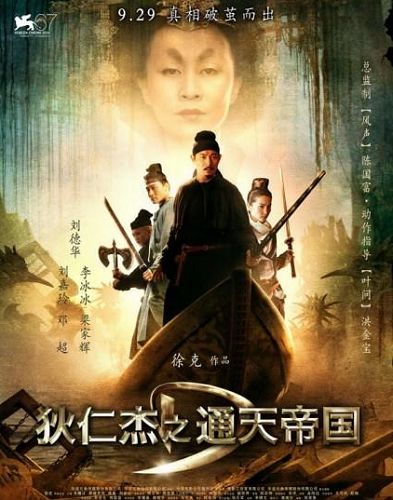The Mercneary saw Detective Dee and the Mystery of the Phantom Flame recently and am happy to pronounce it quite possibly the most steampunk wuxia film I've seen.* It's certainly not the best wuxia film I've seen, but it is packed with some really rather intriguing ideas (many of which are underdeveloped and later abandoned in a really very disappointing second half) and nudges the envelope, at least.
Rambling continues under the cut.
Detective Dee is set during the reign of the Emperor Wu Zetian, China's only female emperor and chronicles the misadventures of an eccentric investigator on the case of the "phantom flame". Dee at first comes across as Holmes-esque in his eccentricities and though they soon evaporate, whilst they last, he is incredibly fun to watch and one could but imagine the film that could have been.
It's steampunk overtones are soon evident, as the film opens with a foreign ambassador visiting the construction of a giant edifice that should be hugely evocative of the Crystal-Palace-Look-What-We-Can-Build vein of steampunk. There is also a phantom bazaar (allegedly built in a city abandoned after an earthquake half-buried it) and some truly spectacular fights (and ones where the fight director appears to have gone mad, but would you argue with the legendary Sammo Hung?). The plot attempts magic realism of the sort where seemingly random supernatural effects are explained by other less powerful supernatural effects (a bit like a Doctor Who episode, really). The attempt at developing the rationality in the face of supernatural powers theme is valiant, but it botches the explanations and believability is severely strained.
At first Dee, Pei Dong Lai (the albino guardsman) and Jing'er (the Emperor's handmaid) all seem to have their own complex and confliting allegiances and motivations. Their first scenes together promise mind games and chess-like manoeuvring around each other throughout the investigation. However, depth and competence of three evaporated as the plot unravelled, calling for them to be confounded by a truly moronic scheme. The film flirts with the exploration of a number of ideas, including a morally ambiguous monarch, reversing traditional gender roles, price of power and rightful sovereignty (versus tyranny), but ultimately the ending is, in all honesty, profoundly unsatisfying, with almost all of the ideas completely unexplored and left hanging.
Still, I do recommend it for the first half and it has inspired a number of thoughts. The costumes are beautiful and the visuals are stunning.
Having a female monarch preside over your steampunk setting just feels right for me and I've been wondering why this is the case. It's probably due to the mirroring of Queen Victoria and the destabilising feeling of the new and novel (another strong theme in steampunk). This is not to say if and when I write my great ricepunk opus I will try to remodel Wu Zetian after Victoria. She is her own, albeit contradictory to the point of schizophrenic, character, but tapping into that imagery of Queens and Golden Ages appears to have a great deal of potential.
--
* The other being 14 Blades, which is aesthetically very ricepunk.


New web site is looking good. Thanks for the great effort.
ReplyDeleteWedding Dresses Canada